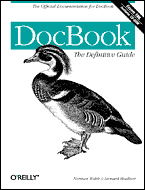DocBook: The Definitive Guide
 | By Norman Walsh & Leonard Muellner 1st Edition October 1999 1-56592-580-7, Order Number: 5807 652 pages, $36.95 , Includes CD-ROM |
| DocBook: The Definitive Guide | ||
|---|---|---|
| Prev | Next | |
Name
IndexDiv -- A division in an indexSynopsis
Content Model
IndexDiv ::= ((Title,Subtitle?,TitleAbbrev?)?, ((ItemizedList|OrderedList|VariableList|SimpleList|LiteralLayout| ProgramListing|ProgramListingCO|Screen|ScreenCO|ScreenShot| Synopsis|CmdSynopsis|FuncSynopsis|FormalPara|Para|SimPara| Address|BlockQuote|Graphic|GraphicCO|MediaObject|MediaObjectCO| InformalEquation|InformalExample|InformalFigure|InformalTable| Anchor|Comment|Link|OLink|ULink)*, (IndexEntry+|SegmentedList)))
Attributes
Common attributes
Tag Minimization
The start-tag is required for this element. The end-tag is optional, if your SGML declaration allows minimization.
Description
An IndexDiv identifies a section of an Index. An index might be divided into sections in order to group entries, usually alphabetically.
An index may contain any number of IndexEntry or IndexDiv elements, but it cannot contain a mixture of both at the same level.
Processing expectations
Formatted as a displayed block.
Parents
These elements contain IndexDiv: Index, SetIndex.